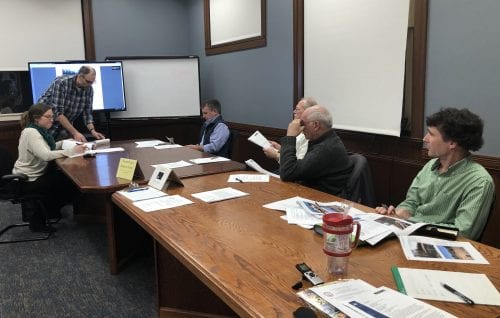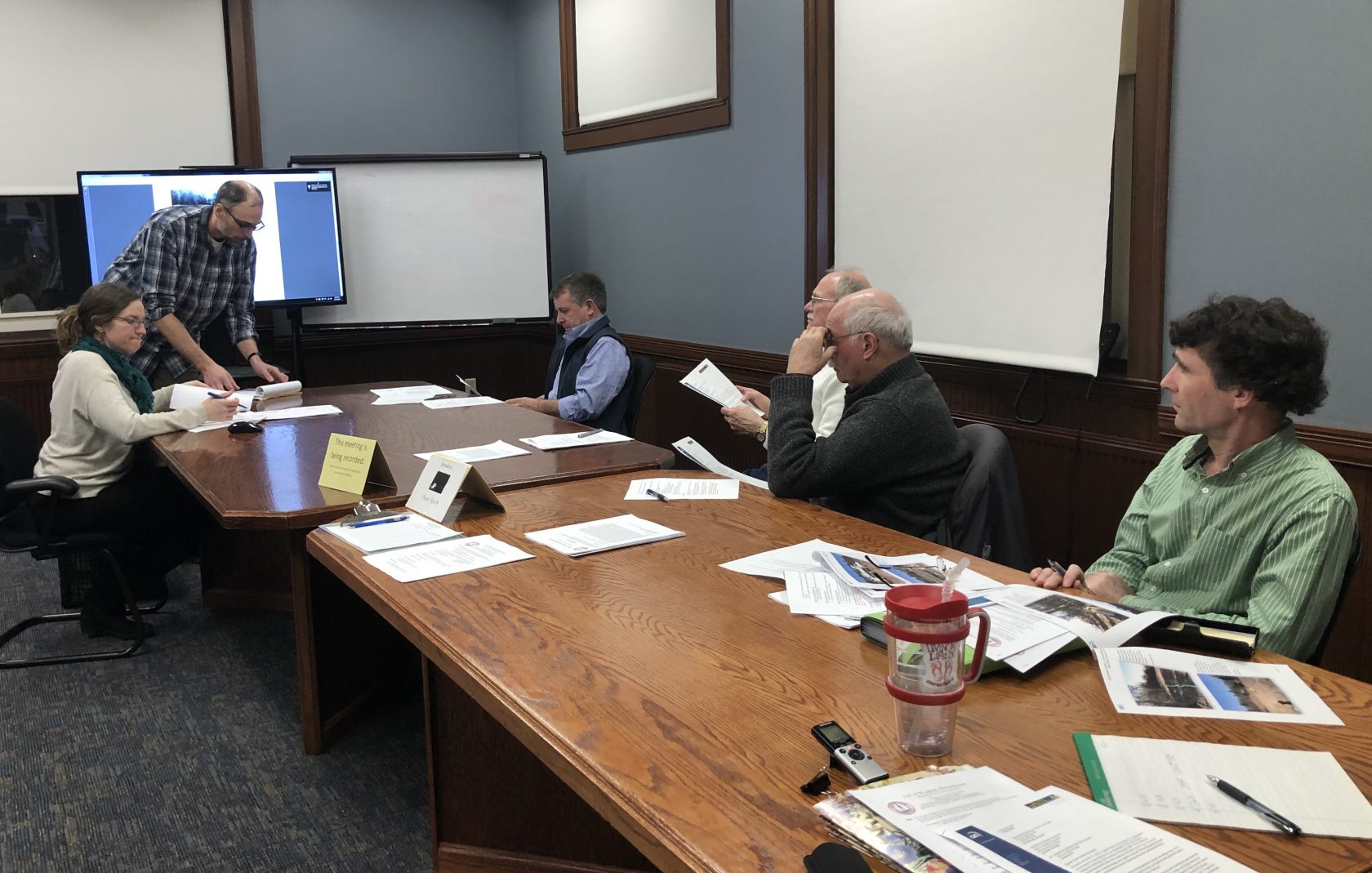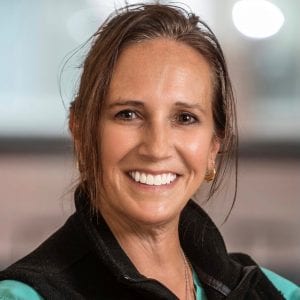
Joe Rogers of GZA GeoEnvironmental goes over East Mt. Road restoration plan with Conservation Coordinator Meredith Borenstein and members of the Commission. (AMY PORTER/THE WESTFIELD NEWS)
WESTFIELD – Four hundred trees will be planted as part of the wetlands restoration plan proposed for an East Mountain Road property.
GZA GeoEnvironmental, on behalf of Mark and Chris Dupuis of 1223 East Mountain Road, presented the plan Feb. 25 during the Conservation Commission meeting.
The trees will replace ones in the nine acres that were cleared in the protected wetland area adjacent to Barry Brook, which is under an enforcement order by the commission. The brothers cleared the land without seeking permission or permits.
The stabilization of the area is “pretty much completed,” said Conservation Coordinator Meredith Borenstein.
“We’re going to try to target 80% cover of exposed soil, with a combination of tree, shrub and herbaceous plantings,” said GZA Project Manager Joe Rogers.
He said originally they had planned on 400 trees from 4 to 6 feet. After initial comments from Conservation and Natural Heritage, they now propose a variation in the age of trees they plant; 60 percent will be 4 to 6 feet, 20 percent 3 to 4 feet, and 20 percent 6 to 8 feet.
Rogers said they have also revised the planting table, taking hemlock out of the equation due to concern about current high mortality from an invasive insect species. He said they added in sycamore, and upped the number of yellow birch, swamp white oak, American elm, and pin oaks to balance the numbers out. He said red maple is the dominant tree in the area.
He said the bigger the tree, the higher the mortality, because the longer the tree is in a pot, the more the roots are stuck in the pot.
“If you took a 10-year tree, because of what you were doing to the root ball, it will spend the first 10 years readjusting the root ball,” Rogers said, referring to studies showing healthy 2 to 3-year trees catching up to 10-year trees. He said younger trees have a higher success rate.
Rogers said GZA will replace trees that die after two years.
“The first year things tend to pause, because the roots are doing their work,” Rogers said. He said herbaceous plantings and dogwoods in the bordering vegetative wetlands along Barry Brook will respond more quickly. “The second year, third year, you’ll start to see the growth,” he said.
Borenstein said she is on the fence about hemlock. “If we’re not planting it, then it won’t be there in the future. Some of it could start being resistant,” she said, adding, “Let’s add some hemlocks back in.”
Carl Grobe agreed, saying, “It would be part of the natural landscape.”
“You have a good broad basis of biological diversity here,” said James Murphy.
Rogers said most of the coverage is going to come from trees, and they don’t want herbaceous plantings taking over. “The further downstream, the more intact the vegetation is. The lower half of the site is probably going to be growing back before we’re even planting it,” Rogers said.
Also discussed was monitoring of the site. GZA originally proposed three years of monitoring of the plantings. Rogers said the Department of Environmental Protection has a minimum of two years, but the commission was proposing 10.
“One thing we would like Conservation to do is five years, with first and second year monitoring, third year replacing the loss, and fifth year monitoring,” Rogers said.
“Are you suggesting years one, two, three, and five for assessments over a five-year period? Natural Heritage really wanted ten,” Borenstein said.
“What are you going to know at year ten that you don’t already know at five years,” Rogers said.
“We’ll know if trees are getting bigger,” Borenstein responded.
“We’ll know whether there’s any more activity going on,” said Clifford Laraway.
Borenstein also questioned boulders that were placed to mark the buffer zone and spread out across the slope. Rogers said they were placed outside of the wetlands jurisdiction area.
Conservation chair David A Doe said they want real signs in concrete that are stretched across the 200-foot riverfront area and along the buffer zone, that reference Mass General Law. Borenstein said they want them marked on the plans. Murphy said the signs will be put in the general order of conditions for the site.
Murphy said regarding the agreement that’s going to occur, one of his concerns is if the current owners sell the property. “We don’t have a Notice of Intention obviously; we’re doing this as an enforcement order. How will this be legally bound,” Murphy asked.
“Right now, it’s through enforcement. If they’re out of compliance, through assessment of fines and court,” Rogers said.
Borenstein asked whether they could put the plan on the deed. She said she would go to the Law Department and ask whether under these circumstances they can bond the project. She said once the area gets restored, the proposed hemp fields and building are out of Conservation’s jurisdiction.
Commission members also agreed they would like to see ten years of monitoring.
Inviting comments from attendees, Ward 6 Councilor William Onyski said he agreed with investigating as to how to put a performance bond into the agreement, and with the ten-year monitoring.
Resident Kathleen Hillman of Susan Drive said there are now beavers building an 8-foot dam upstream in Barry Brook, which has reduced the flow to a trickle. Murphy asked whether beavers had been seen before, and Richard Morini said he’d been there 40 years, and didn’t remember having them. However, Morini said he didn’t know for sure.
Sherry Morini asked if they had a permit.
Borenstein said the beavers were on another property, and not under their jurisdiction.
The Commission said they would request that GZA attend the March 10 meeting to finalize the restoration plan. “We want to get this wrapped up so they can get it out to bid and planted in April or May,” Borenstein said.








